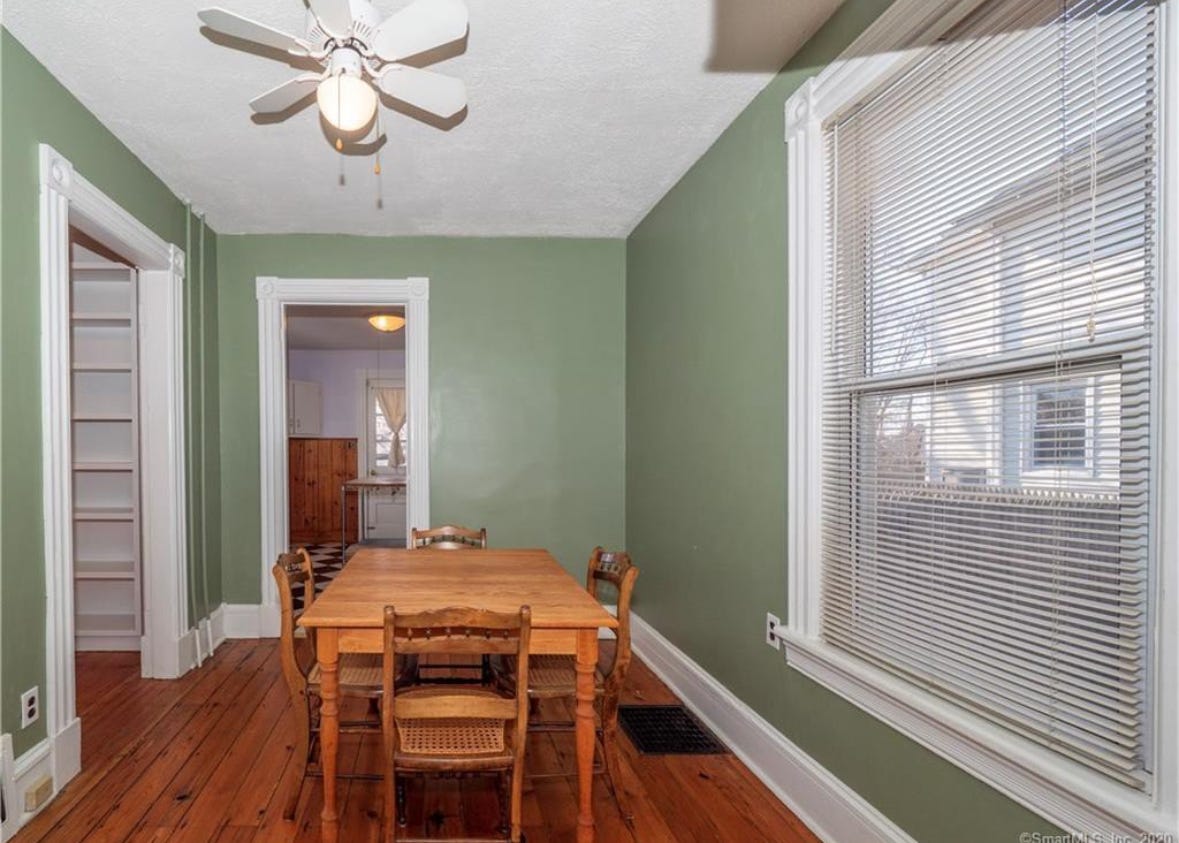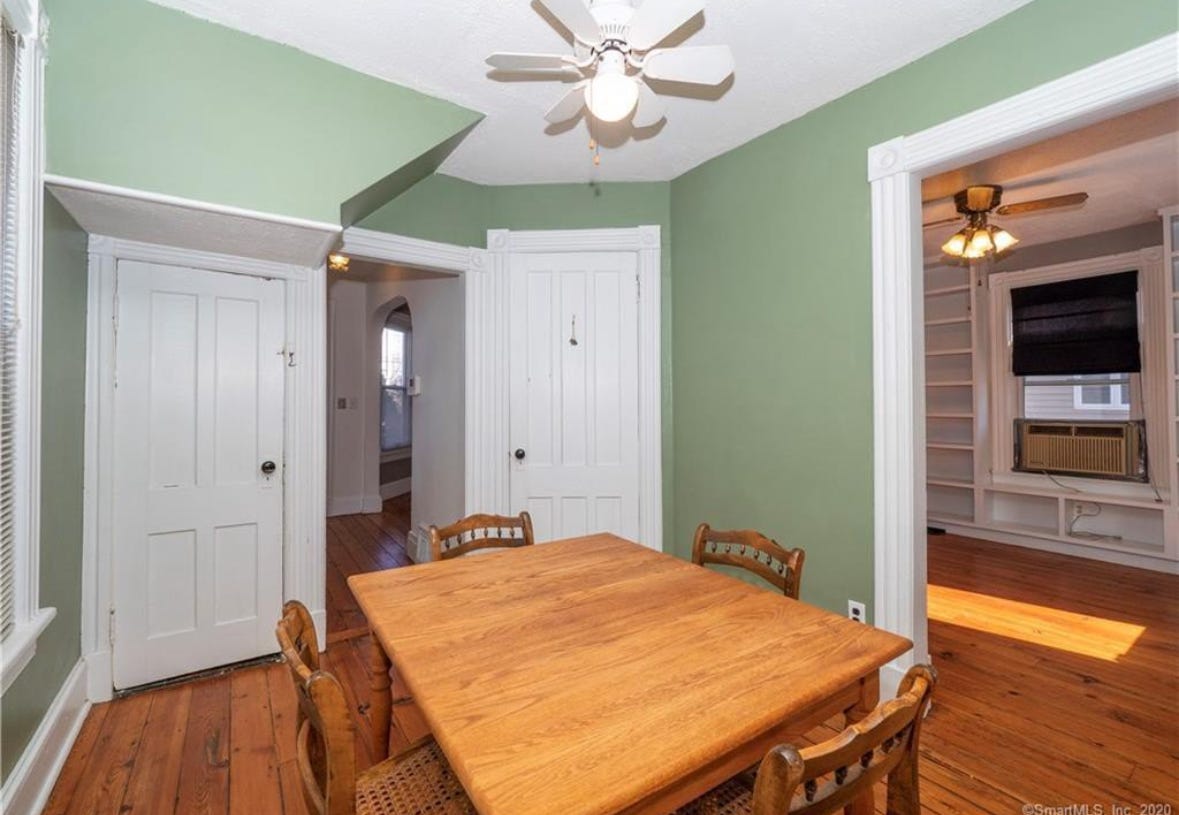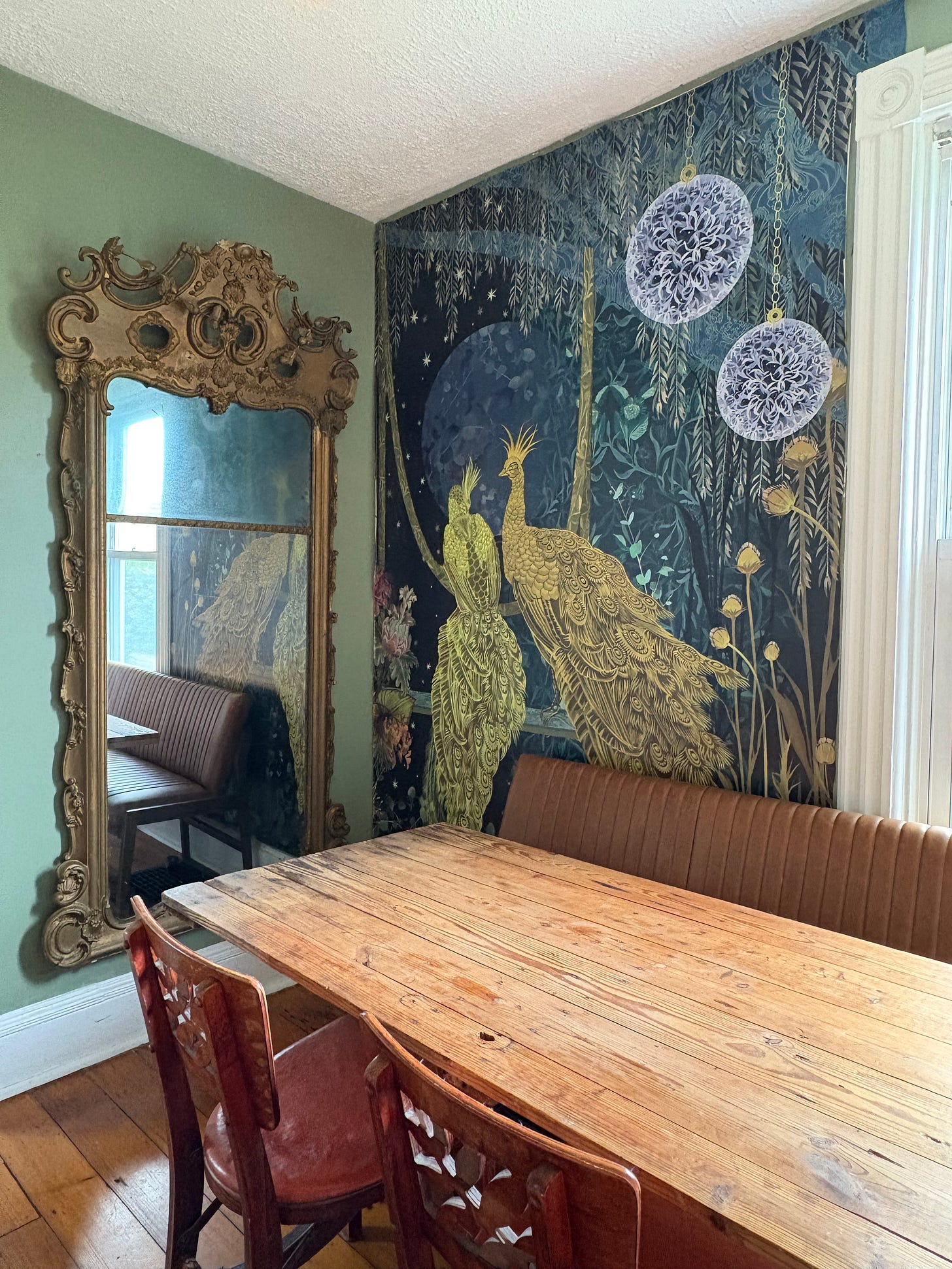In 2020, my husband and I bought a house. It’s our first house, and also hopefully our last: a little Queen Anne Victorian with two bedrooms, gorgeous light, and absolutely no creepy evil vibes despite its fairly advanced age.
It does, however, have the world’s most cursed dining room.
The room is extremely small — 8.5 wide by 9 feet long — with one window and five (5!!!) doorways, two of which have actual doors on them that open outward, into the room. One of said doors goes to the basement, the other to a coat closet — the interior design of which confused the hell out of me for fully two years until I realized that this room used to be the kitchen, and the closet was actually a pantry. The current kitchen was a circa 1930s addition to the original 1880s house, and I sometimes wonder if the owners at that time had any notion of how incredibly awkward this space would be once the stove and such were relocated elsewhere. What did they think they would do in here? What did they do? Walk in and out of the various doorways recreationally, maybe. It was a different time.
Anyway, this room has always been a thorn in my side, decorating-wise. It's more like a second hallway than a usable space. You have to walk through it to get to the kitchen, which in combination with the doorway situation (this room is, I swear to god, fully 85% doorways) means limited furniture placement options. But, also because of the doorways, and through some miracle of Victorian-era architectural design, it has sightlines to every other room downstairs as well as to the front door, i.e. it actually needs to look at least halfway nice because you can see it from everywhere.
I won't bore you with (any more of) the details; suffice to say that four years and roughly 30,000 "tiny dark narrow dining room" Pinterest searches after moving in, I'd figured out a setup with a banquette bench and a wallpaper mural that a) worked well enough on the rare occasions we actually ate a meal in there, and b) more importantly, looked cool from other rooms as well as in the background of Zoom calls and the occasional media hit. (I never did get room rated but fully admit the fear of being roasted by them was, during those long, dark months of the pandemic, extremely real.)
And yet: I still felt like something was missing — something that would, in the parlance of a certain Coen brothers film, really tie the room together.
Cut to a latenight insomniac scrolling session on Facebook Marketplace, where I discovered a treasure. Not a rug (I still can’t find one to fit the room’s weird-ass proportions), but a giant antique gilded mirror that looked like something out of a bedroom at Versailles, which would take up the entire wall at the end of the table, and which owing to the good-not-great condition of its plasterwork was being sold for an insanely reasonable $250.
There was just one problem, which I realized only after the mirror was already inside my house: I had no idea how to hang a hundred-pound object on a 150 year-old plaster wall without causing potentially irreparable damage to both, and neither did my husband. Also, we were both very tired and cranky at that point, our afternoon having consisted of a three hour roundtrip drive to upstate New York to pick up the mirror, where the seller and I spent half an hour awkwardly chatting while our spouses wrangled it down a flight of stairs and into the car in grim, masculine silence punctuated only by the occasional grunt.
And so we just sort of leaned the mirror against the wall we eventually intended to hang it on, and left it there.
For a year.
And this is where ChatGPT comes in.
Earlier this month, I finally got disgusted enough with the mirror-on-floor situation to both ask a carpenter friend if he would come hang it for us, and then, because the friend was taking too long, visit a local hardware store and find out what sort of hardware a person would hypothetically need to hang a 100 pound object on a plaster wall. I also suspected, based on the mirror's weight, construction, and previous life as a mantel fixture in an 1870s Italianate brownstone, that it would probably be a good idea to recreate the basic structure of its original setup using two different support systems: a ledge (or in my case, 2-inch L brackets) at the bottom to rest on, and a picture hook with wire at the top to keep it from tipping forward.
But there is a difference between thinking you have a good idea, and being confident enough about it to start drilling finger-sized holes into a wall that is older than your great-great-grandparents. I was afraid to do this! I needed reassurance that what I intended to do made logical sense, that it was going to work, that I wasn't going to accidentally tear the entire house down — and ideally, I wanted these things without being second-guessed or condescended to by the kind of hardware store employee (#NotAllHardwareEmployees, but enough of them) who seems to think that having a vagina makes you functionally retarded. So I told ChatGPT what I was thinking about doing, sent it some pictures of the space and my tools, and… it was amazing?
The chatbot gave me:
a detailed explanation of 1880s construction, including what was likely to be behind the wall I was drilling into and real-time feedback on what I was seeing and feeling when I made a pilot hole
confirmation that I needed to offset the picture hook to account for asymmetry in the hardware on the mirror
a suggestion that I pad the brackets with felt to reduce stress and friction on the wood frame (something I probably wouldn't have thought of on my own), and
a thoughtful last-minute pep talk when I confessed that I was irrationally afraid of drilling holes in the wall because it seemed disrespectful to the house — which is not a thing I would have ever admitted out loud to a hardware store guy because it sounds insane, but was honestly really weighing on me.
I imagine some people would say that this is an extremely niche use case for AI and hence not a good example of anything — or maybe they'd argue that it's sinister, actually, because what if everything ChatGPT claimed to know about plaster was a hallucination and how would I ever know? But these are good arguments for maintaining a certain amount of curiosity and skepticism about the use of AI, and perhaps for not wholesale outsourcing your problems and your process to it; I don't think they make a persuasive case that it can't be good for anything, ever. And as for the good-for-something, I mean.
Say what you will about the chatbot, it is the reason why I have a (fabulous, extremely securely-mounted) mirror on the wall of my cursed dining room, as versus being still crouched in front of said wall clutching an electric drill like a weird little gremlin and arguing with myself, Gollum-style, about whether it is okay to decorate my own home.








Have you ever noticed that the second peacock reflects as a face in the mirror? And can you now unsee it?
Your dining room is just lovely- the wall paper and mirror have so much expression and character. They seem to be telling a story:) the trip up state was definitely worth it and gotta love chat gpt!